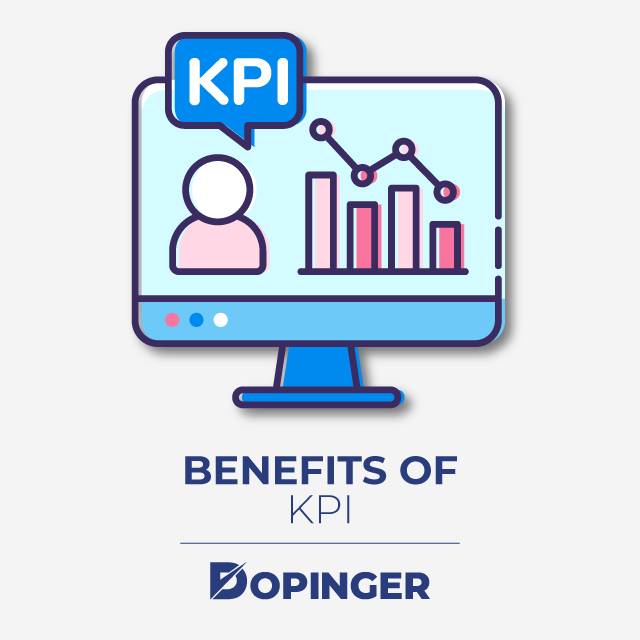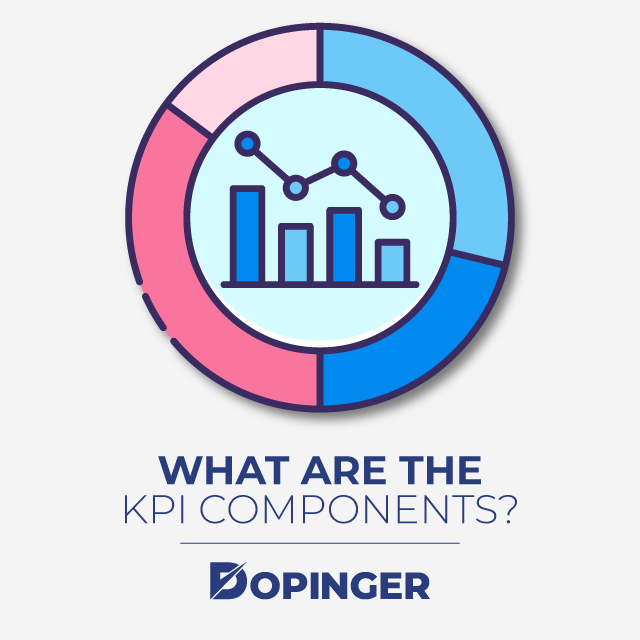KPI consists of the initials of the Key Performance Indicator words. Every company, business, or company has a set of goals that will help it take its place in the market. As you know, these goals shape the purpose of the organization. KPI Key Performance Indıcator is also a definition that shows the current value and position of the business. So it gives clues about the performance of the business. Key Performance Indıcator is an increasingly important term in order to find answers to questions. The questions are such as what you can do for your goals, what is important for your company and what you can do to improve your company.
If we make it a little simpler, let’s say you will buy a car. You went on a test drive before buying. The car can travel at a maximum speed of 250 km / h. You want the car to reach 300 km / h. Here, your target is 300 km / h, and your performance indicator is 250 km / h. As a result of the studies carried out, can your needle shows 300 km / h, or have your speed decreased further? This is what we call this measure KPI Key Performance Indicator.
KPI Definitions of Each Sector Should be Different
Because the dynamics of the sectors vary. For example, let’s consider the accounting and marketing departments in the same company. Performance measurements of these departments with different goals are also different. Since KPI (Key Performance Indicator) is a performance measurement according to the target, it should be defined separately for each sector.
Since KPIs are an important part of performance management, most employees can also have a fearful dream. That’s why its correct determination is important at this point. So, it is possible for your employees to improve their performance with the correct KPI. You can reach your goals with its strategic objectives by seeing KPI as an element of development.

What Are the Benefits of KPI?
First of all, when the KPI is correctly determined, it helps the employee to develop continuously. With KPI, the employee is expected to be productive and not counted on-site, rather than constantly working.
Also, it provides verifiable measurements of the business process from the starting points to the end of the process.
Besides, it is a source of motivation for employees who had been doing the same jobs for years. Because these employees may feel inadequate and useless after a while. The employee, who has a good KPI, will see that his work is sufficient for his company.
Finally, it ensures that the discipline of the employees in the teamwork is followed by the managers step by step. It offers to measure and report on individual and team success. In a way, it plays a role in the success of a balanced scorecard.
What Happens If There Is No KPI?
First of all, the main secret of success in business life is the continuity of success. A discontinuous success ensures that your short-term goals are fulfilled while it is ineffective in your long-term plans, such as customer satisfaction. Another key component of success is that it is measurable. What can you be considered successful when you have a result you cannot measure?
So, the KPI Key Performance Indicator provides good leadership in achieving your strategic goals. It brings success in the long term by evaluating your measurements.
How Is the KPI Key Performance Indicator Determined?
The correct determination of KPI Key performance Indicators is crucial for the achievement of the goals and the success of the business. Incorrectly identified KPIs could have bad consequences such as low motivation and loss of self-confidence. This can do more harm than good to the business.
On the other hand, it is important to know and be involved in the process of preparing a KPI and using it well. At this point, there are some questions that managers should ask themselves in the Key Performance Indıcator. These questions should cover the SMART KPI Key Performance Indıcator criteria.
So What Are the SMART KPI Criteria?
The goal is to be specific, measurable, achievable, appropriate, and time-limited. So:
- How suitable is the specified target business’s field of operation?
- Is the target set specific to the business?
- How accessible is the target business for?
- How much time is needed to reach the set goal?
- Can the planned process be measured to achieve the specified goal?
1) Industry Specificity:
Key Performance is perhaps the most important step in determining Indicators. Since each sector will have separate targets, their KPIs should also be different. A clear and specific goal should be focused and confusion should be avoided. In addition, when determining key performance inductors, the employee and the owner must be in communication and coordinate. It should not be forgotten that the aim is not to put the unnecessary and intense workload on the employee. The aim of the KPI Key Performance Indıcator is to ensure the efficiency of the employee.
2) Timing:
Key Performance Indicators, in other words, when determining targets, the deadline should be determined. Completing goals in a specific real-time interval will make it a more successful template in KPI Key Performance Indıcator.
3) Measurability:
The fact that the target is measurable is essential for the definition of success in Key Performance Indıcator. Therefore, the target should be on a clear and specific subject, even if it is not quantitative and measurable.
4) Eligibility:
The eligibility criterion should be handled realistically. In other words, many factors, such as the employee’s capacity, competence for work, health status, and psychology should be considered together. Targets should also be determined according to these factors.
5) Accessibility:
Finally, the accessibility criterion is directly proportional to suitability. So, the availability of KPI Key Performance Indıcator depends on the determination of targets suitable for the employee and operator.
Some KPI Examples
- Annual Revenue Increase Rate
- Number of Persuaded and Retained Customers
- Number of New Customers
- Continuous Service Time
- Pending Collections
- Failure and Solution Time
- The Rate of Entering Customer Data to the System
KPI Key Performance Indıcator examples here can be increased. The important point is that the performance measurements in the company are made correctly to be successful in the KPI dashboard.

What Are the KPI Components?
Firstly we can examine KPI Key Performance Indıcator components under 7 headings:
1) Performance Measure:
Performance measures, budgets, and estimates invoicing and income, costs, effort, margin, capitalization that we can benefit from. With Oracle Fusion Project Performance Reporting, you can also get an objective idea of the performance of your project. You can also create various measures to meet the needs of your business with these measures. If we exemplify the predefined performance measures, these are as follows:
- EAC Budget Cost (the estimate at completion burdened cost from the current baseline budget)
- ITD Forecast Revenue Variance (the inception-to-date current baseline budget revenue – currently approved forecast revenue)
- Prior Period Margin Percentage Variance (the prior period current baseline budget margin percentage – actual margin percentage)
- However, performance metrics are often handled over time. The time definitions that performance measures can be associated with are as follows:
- Estimate-at-completion (EAC)
- Inception-to-date (ITD)
- Prior Period
- Period-to-date (PTD)
- Quarter-to-date (QD)
- Year-to-date (YTD)
2) Performance Status Indicator
Performance status indicators provide information about your project. It makes qualifications such as critical, severe, risky, follow-up, and ahead related to your project. Then you compare these situations to the threshold levels you have previously determined and evaluate your performance. You can also take measures related to your poor performance.
3) Threshold Level
When defining the KPI, you must set a threshold value that covers all possible values for a KPI Key Performance Indicator. It is especially useful when evaluating near-border performances, such as threshold values, insufficient use, or overuse of resources. Also, if a KPI value exceeds threshold levels, the closest threshold value determines the KPI status.
4) Trend Indicator
Performance trend indicators give you a table related to your KPI Key Performance Indıcator values. The icons in this table indicate whether your increased performance has positive or negative effects. So you can make evaluations about your performance.
5) Tolerance Percentage
Percentage of tolerance offers the opportunity to compare with your current value. So you can show that your performance trend is increasing or decreasing. For example, your tolerance percentage is 10%. If the difference between your previous KPI value and your current KPI value is greater than 10%, your trend will increase. If this difference is between 10% and -10%, your trend does not change. Less than -10%, your tendency will decrease. So you can make positive and negative evaluations with the tolerance percentage.
6) Project Performance Data
Project performance data is used when creating KPI values. The period in which you produce KPI values is within the KPI Period Determination Date. The data you entered for this period takes place in the project performance control panel. Thus, your data is saved clearly.
7) Project Unit
Finally, the project unit. Each of the KPI Key Performance Indicators you create is for specific project units.
How about turning the content you trust most into a lead generation tool with content syndication? You can market many types of content this way, such...
If you have experience searching for things like restaurant reviews on the internet, you've definitely come across Yelp. If you are looking for an onl...
So, by using these components, you can increase your net profit margin in line with a good KPI strategy.

Lack of KPI Tables
The key deficiency in KPI Key Performance Indicator tables is competitor analysis. Businesses can often ignore competitor analysis while focusing on customer satisfaction. However, competitor analysis is a must for marketing and planning.
Besides, the market you are in is extremely dynamic and volatile. In other words, you are rival companies in the eyes of your customer. And you should have an idea about how your market situation is perceived. So you should know your real competitors and know their position in the market. Thus, you can understand the strengths and weaknesses of your competitors. Also, you can eliminate the threats that may occur against you.
On the other hand, you can find answers to the following questions with competitor analysis:
- Who are our main competitors, and why are they your competitors?
- What are the goals of our main competitors, and how are these goals different?
- What are the strengths and weaknesses?
- Which ones pose a threat?
- What opportunities do they offer?
- What strategies do they follow, and how do they affect us?
- Based on their past actions, how can they respond to changes in our businesses?
Where to Find Competitive Data?
The most important places where you can find competitor data are recorded data such as annual reports, product brochures, and marketing activities. You can also catch clues about your competitors’ work in business magazines and newspapers. You can find these statements using media monitor services and Google Alert.
On the other hand, there are opportunistic data such as competitor pricing data, advertising campaigns, fairs, supplier meetings, sales force meetings.
We have always talked about the recorded data. These data are generally formed as a result of laborious analytical studies. However, you can access this data online. Social media and various forums such as Facebook pages can help you in this direction. With these channels, you can read competitor product reviews and customer reviews and make comparisons. So, in this way, you can have the opportunity to review your financial metrics with difficult data, basic market indicators, and benchmarks.
KPI In Short
Firstly, KPI stands for Key Performance Indicator. KPI Key Performance Indicator aims to increase the efficiency of employees and businesses in line with certain targets. Also, since each department’s target will be different, KPIs should be evaluated according to performance measurements. When determining the KPI Key Performance Indicator, the target should be specific, measurable, achievable, appropriate, and time-limited. On the other hand, by following the competitor data, you can get maximum efficiency from KPI. And you can increase your net profit margin.
If you liked this article about KPI, please check out our other articles about digital marketing. You may like inbound marketing.





1 Comment
KPI is an important tool for measuring success, but it can be difficult to understand. Your blog post is a great introduction to the concept, but I’d suggest providing more examples to help readers better understand how to use KPIs.